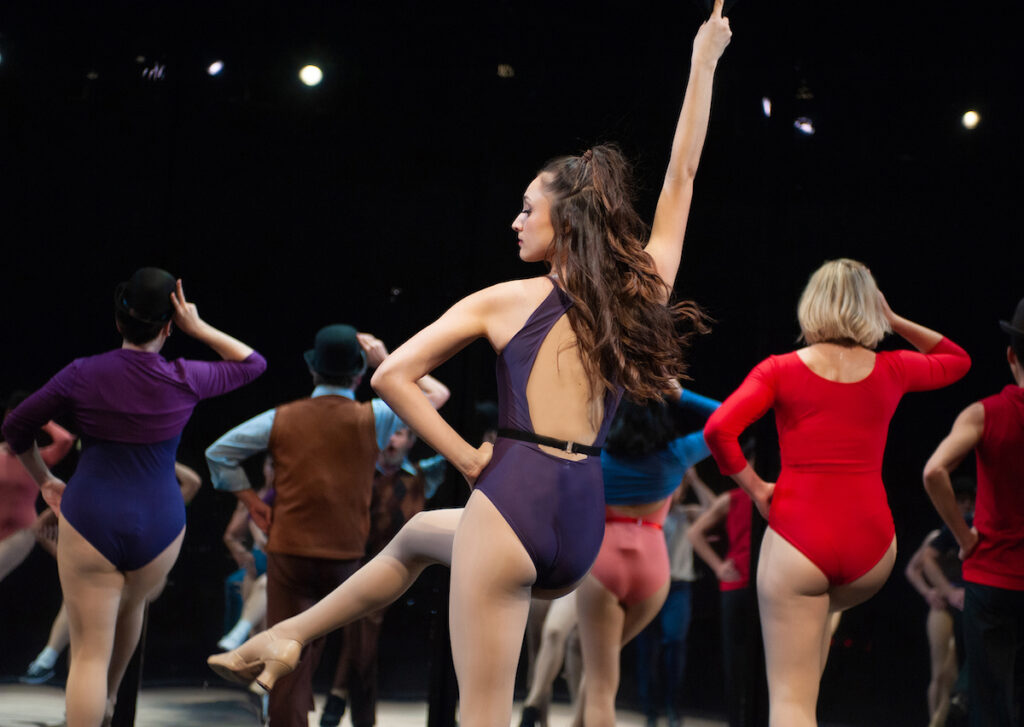As weird (and, some would say, pretentious) as it is for actors to look at famous roles as projects they might take on “one day,” it’s even weirder to say it about A Chorus Line (through September 16 at SF Playhouse). Sure, the songs are great, but it’s a play about theatre people going through that most necessary of evils—auditioning—and kvetching about how much they hate theatre. That, and their parents.
Then again, that’s always been the appeal of Marvin Hamlisch and Edward Kleban’s classic, hasn’t it? The book by James Kirkwood Jr. and Nicholas Dante isn’t some glamorous tale of plucky young performers finally getting their time to shine before the Happily Ever After. No, A Chorus Line is about how performing in front of auditors is akin to standing in front of a firing squad.
It’s a show that focuses on dancers knowing that they’re the second-most interchangeable performers (I’d say right beside choral vocalists, but both are ahead of supernumeraries) and forces us, the audience, to deal with the fact that these are people with lives lived before they arrived at the theater; lives to which they’ll return as soon as they leave. It’s a musical that gives a voice to the performers whose very job is to keep their mouths shut.
Hamlisch, Kleban, Kirkwood, and Dante drew their characters’ stories from a series of auditions not unlike that depicted in the show itself. Each character is an amalgam, yet incredibly specific in their backstory. It’s a show that demands a cast of unknowns because the addition of stars would just be a painful distraction; such was the case when the non-dancing Michael Douglas was cast in Richard Attenborough’s film adaptation.
The casting of strangers works both for and against the Playhouse version. Director Bill English (also the Playhouse’s AD) clearly wanted performers who could dance, act, and sing, but he seems to have settled on an ensemble from which only a few can do all three. A lot of the times, you’ll have OK actors who are great singers, but aren’t the strongest dancers. Then you’ll have fantastic dancers whose vocal readings come off like Allan Sherman impressions of the old “Nu Yawkah” stereotype.

At one point, it almost seems like meta-commentary for the characters to describe how there isn’t a demand for such hybrid performers anymore. The 1975 show was first produced at a time when the big Broadway musical was, like its Hollywood counterpart, considered passé in the grit-driven Nixon era. (Incidentally, it was musical like The Wiz and A Chorus Line that helped revive The Great White Way to its glory.) When the characters leave the theatre, they either need to do so having been cast or wonder where their next meal is coming from. And for one-time headliner Cassie (show choreographer and Playhouse regular Nicole Helfer), it would hurt twice as much at this point in her career.
English’s production winds up with mixed performances, such as that of Keith Pinto, who fares better than Michael Douglas in that he can actually dance, but seems unsure of himself when delivering dialogue. Then you Danielle Chaiken as Maggie: she’s an adequate enough dancer, but those of us who have followed her career know that one of the show’s highlights will be when the classically-trained vocalist crushes the high note of “At the Ballet” (which got its own applause at the performance I attended).
Yet, if any one performer walks away with the show, it’s Jillian A. Smith as Bebe. It’s not just that she can sing and dance, it’s that when she acts, she fully personifies the entire premise of the show. Her wide eyes hide a heart on the verge of breaking if she isn’t cast because she can’t really do anything else—nor would she want to. She holds the audience’s attention every moment she’s on English and Heather Kenyon’s blank stage (occasionally added to with dancing mirrors and a sparkly final piece revealing the band). Whereas most of the cast seem preoccupied with playing the archetypes of their characters, Smith is the one who consistently makes Bebe her own.

When the Playhouse returned to live performances two years ago, their COVID safety measures were exemplary for other theatre companies. But when I saw A Chorus Line during its first “Safe Sunday” performance, I happened casually overhear the house manager mention that it’ll be the only such performance for the entire run. The company is looking to phase out all of its COVID measures. Indeed, the HM was the only staff member I saw masked, and had to remind the man getting tickets in front of me about it. He said he couldn’t remember the last time he wore a mask to one of their shows.
Though their top-notch HVAC system kept my Aranet4’s CO² readings hovering at ~561ppm for the entire show, a key scene focuses on how a single injury can end both a production and a performer’s career. In that regard, it’s hypocritical of the Playhouse to be so lax about COVID, which could potentially end both of those, as well as someone’s life.
One hopes that this cast makes it through the entire run unscathed. Though not every performance hits all the right steps (both literally and figuratively), A Chorus Line remains an entertaining peek behind the curtain at the hair-pulling process through which performers put ourselves. That the show is only dated in the most trivial ways speaks to its lasting appeal and relevance. It’s a show about unknowns leaving a lasting impression. I’m glad to say that several of them actually do.
UPDATE: the press representative for SF Playhouse contacted me to explain that there will be two additional COVID-safe performances—Sunday, August 6th and Sunday, September 3rd—and that The Playhouse will indeed have COVID-safe performances during their upcoming 2023-24 season.
A CHORUS LINE runs through September 16 at SF Playhouse. Tickets and further info here.





